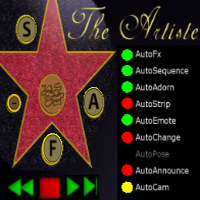It had been a while since I had been challenged to perform live in an "uncontrolled" setting, but when I had the chance to volunteer for the Lovecraft Festival 2014 I jumped in both feet.
The HPL RPG group stage a festival each year around the time of H.P. Lovecraft's birthday and raise funds for Autism Awareness. As part of that festival they have live shows, amongst which is a cabaret. To cut a long story short, we ended up with merry band comprising of myself, Yummy, Else Barnard and Candace Bethune.
The Arena
Restricted to a medium to small space inside a large circus style tent, which had an irregular shape inside and so I plumped for an oval stage with a fade-able screen we could use to cover scene changes. The original tent was on the "ground" and set at a 45 degree angle which presented its own problems (see comments on set up and moving)
Eventually this was moved to a sky platform and re-oriented to 0 degrees.
The Theme
I was trying to keep this as closely tied to Lovecraft as possible, but a lot of his ideas are cerebral and not easy to represent in a tangible format (applause to HPL who keep pulling it off though), so I left it at "Tales of the Uncanny" and the brief was "a turn of the century X-files from the journal of an explorer of the unknown"
The Role of The Artiste (click on Title links for videos)
The Call of the Siren Video - Parting Sky and Sea
1. A two part move, bringing the avatar up from "underwater" to the surface and forward as if walking out of the sea. At a later point the avatar is moved further forward to expose the feet and dance at the very edge of the sea. When I repeated this performance at Sinners, I added the 3rd move to drag the "creature" back into the sea and avoided being stranded beyond the curtain.
2. Use of an oscillating fade (oscfade) to move between two background images. The original idea was to have it fading in and out constantly but I left it with one or two reveals. We now have an adjustable interval between fades so you can control the changes.
The Sacrifice Video - Vanishings and Voids
1. Moving the main avatar down from the steps and forward from the dance.
2. Moving the second avatar on the altar upwards in a levitation effect. The palette used for this was also a particle emitter so it shrouded the "Vanishing"
3.Compensating for the difference in two animation positions by using the palette to match them up. (see also:
Explanatory video of sit-2-sit (animation re-centering)
4. "Vanishing" the second avatar- using a sit to sitmove from the elevated palette to one backstage
5. Reveal and rotation of the "black hole" Rotation of a second textured but invisible cone which was then made visible
6.Sucking the first avatar back into the abyss - one long sweeping move with a suitable animation, taking the avatar up and back and through.
(The Artiste also controlled the reveal screens on my stage, which was a palette using fadehide/fadeshow)
Set Up and Moving
Although the anchors and palettes will adjust on a 90-degree rotation when you transfer from one location to another (right angles, as most theatres are set on the straight) I did have a problem with the 45-degree angle as it knocked the position of the moves astray. Obviously if you are doing an "outside" show then the remedy is to check the rotation of your potential stage and if it is at a certain angle (and that can't be changed) then do your set up at that angle or set up your moves in-situ.
I simply re-did my moves on the stage and they worked fine, but then we decided to go for the straight stage after all! I was trying to make life easier for other people and ended up just making life difficult for myself. Lesson learned!
The sets were packed up in a traditional rezzer and opened up at the other end with no issues about positioning. I reset each palette in turn when the scene was rezzed just to be on the safe side, but in rehearsal they performed over and over.
Performance
I am not sure how many people exactly we had packed into that tent on the night of the show, but the sim was maxxed out and I think we were lucky that we didn't have a huge amount of lag to contend with, but there was a fair amount. On the whole The Artiste behaved itself extremely well, with one judder as I was swept back into the abyss. The sit-to sit went without a hitch, and the levitation looked great.
This was the first time that I had used many of these techniques in a live situation but I felt totally confident about the performance.
Thank you to Yummy for her support and to Else and Candace for stepping in and helping out with their own wonderful routines, many thanks to HPL and in particular Arik) for the chance to put the show on; for all the wonderful people involved who were so helpful and the appreciative audience who donated so much to the charity during the show.
Lastly, special mention to my little brother Aodhan, who introduced me to these wonderful people, and made it all possible :)
See you all there next year!
http://hplrpg.wordpress.com/2014-lovecraft-festival/lovefest-2014-events-schedule/
https://www.flickr.com/groups/hplfaire/

